TOYOTA TACOMA 2021 Owners Manual (in English)
Manufacturer: TOYOTA, Model Year: 2021, Model line: TACOMA, Model: TOYOTA TACOMA 2021Pages: 608, PDF Size: 12.67 MB
Page 481 of 608

4817-2. Steps to take in an emergency
7
When trouble arises
WARNING
■If both the ABS and the brake s ystem warning lights remain on
Stop your vehicle in a safe place immediately and contact your To y o t a
dealer. The vehicle will become extremely unstable during braki ng, and the
ABS system may fail, which could cause an accident resulting in death or
serious injury.
■ If the tire pressure warning light comes on (if equipped)
Be sure to observe the following precautions. Failure to do so could cause a
loss of vehicle control and result in death or serious injury.
● Stop your vehicle in a safe place as soon as possible. Adjust the tire infla-
tion pressure immediately.
● If the tire pressure warning light comes on even after tire inf lation pressure
adjustment, it is probable that you have a flat tire. Check the tires. If a tire
is flat, change it with the spare tire and have the flat tire repaired by the
nearest Toyota dealer.
● Avoid abrupt maneuvering and braking. If the vehicle tires deteriorate, you
could lose control of the steering wheel or the brakes.
■ If a blowout or sudden air leakag e should occur (vehicles with the tire
pressure warning system)
The tire pressure warning system may not activate immediately.
■
Maintenance of the tires (vehicles with the tire pressure warni ng
system)
Each tire, including the spare (if provided), should be checked monthly
when cold and inflated to the inflation pressure recommended by the
vehicle manufacturer on the vehicle placard or tire inflation p ressure
label (tire and load information label). (If your vehicle has t ires of a dif-
ferent size than the size indica ted on the vehicle placard or tire inflation
pressure label [tire and load information label], you should de termine
the proper tire inflation p ressure for those tires.)
As an added safety feature, your vehicle has been equipped with a tire
pressure monitoring system (TPMS -tire pressure warning system) that
illuminates a low tire pressure telltale (tire pressure warning light)
when one or more of your tires is significantly under-inflated. Accord-
ingly, when the low tire pressure telltale (tire pressure warni ng light)
illuminates, you should stop and check your tires as soon as po ssible,
and inflate them to the proper pressure. Driving on a significa ntly
under-inflated tire causes the tire to overheat and can lead to tire fail-
ure. Under-inflation also reduces fuel efficiency and tire tread life, and
may affect the vehicle’s handling and stopping ability.
Page 482 of 608
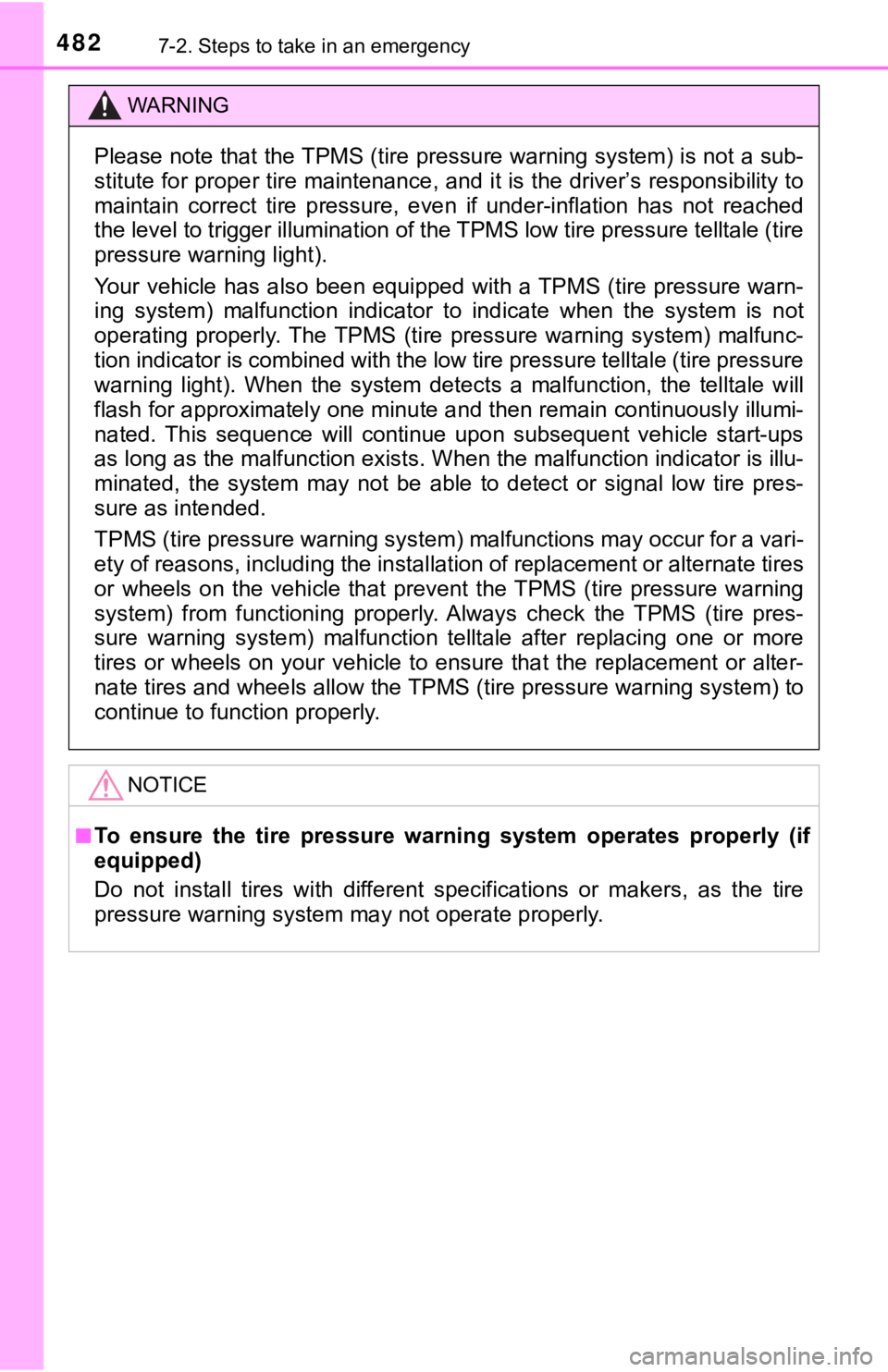
4827-2. Steps to take in an emergency
WARNING
Please note that the TPMS (tire pressure warning system) is not a sub-
stitute for proper tire maintena nce, and it is the driver’s responsibility to
maintain correct tire pressure, even if under-inflation has not reached
the level to trigger illumination of the TPMS low tire pressure telltale (tire
pressure warning light).
Your vehicle has also been equipped with a TPMS (tire pressure warn-
ing system) malfunction indicato r to indicate when the system is not
operating properly. The TPMS (tire pressure warning system) mal func-
tion indicator is combined with the low tire pressure telltale (tire pressure
warning light). When the system detects a malfunction, the tell tale will
flash for approximately one mi nute and then remain continuously illumi-
nated. This sequence will continue upon subsequent vehicle star t-ups
as long as the malfunction exists . When the malfunction indicator is illu-
minated, the system may not be able to detect or signal low tir e pres-
sure as intended.
TPMS (tire pressure warning system) malfunctions may occur for a vari-
ety of reasons, including the installation of replacement or al ternate tires
or wheels on the vehicle that prevent the TPMS (tire pressure w arning
system) from functioning properly. Always check the TPMS (tire pres-
sure warning system) malfunction telltale after replacing one or more
tires or wheels on your vehicle to ensure that the replacement or alter-
nate tires and wheels allow the TPMS (tire pressure warning sys tem) to
continue to function properly.
NOTICE
■To ensure the tire pressure warning system operates properly (i f
equipped)
Do not install tires with differ ent specifications or makers, a s the tire
pressure warning system may not operate properly.
Page 483 of 608
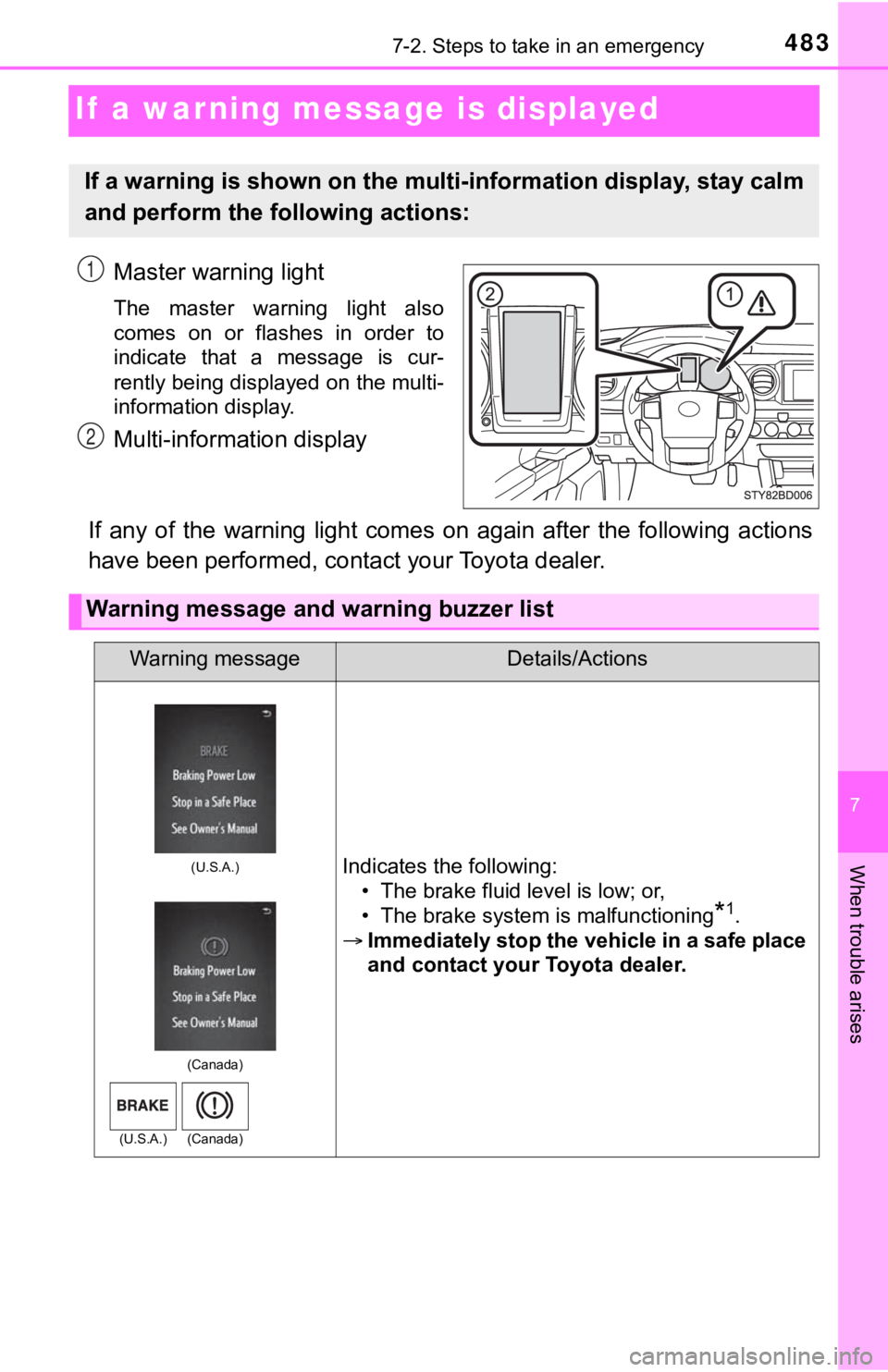
483
7
When trouble arises
7-2. Steps to take in an emergency
If a warning message is displayed
Master warning light
The master warning light also
comes on or flashes in order to
indicate that a message is cur-
rently being displayed on the multi-
information display.
Multi-information display
If any of the warning light comes on again after the following actions
have been performed, contact your Toyota dealer.
If a warning is shown on the multi-information display, stay ca lm
and perform the following actions:
1
2
Warning message and warning buzzer list
Warning messageDetails/Actions
Indicates the following: • The brake fluid level is low; or,
• The brake system is malfunctioning
*1.
Immediately stop the vehicle in a safe place
and contact your Toyota dealer.
(U.S.A.)
(Canada)
(U.S.A.) (Canada)
Page 484 of 608
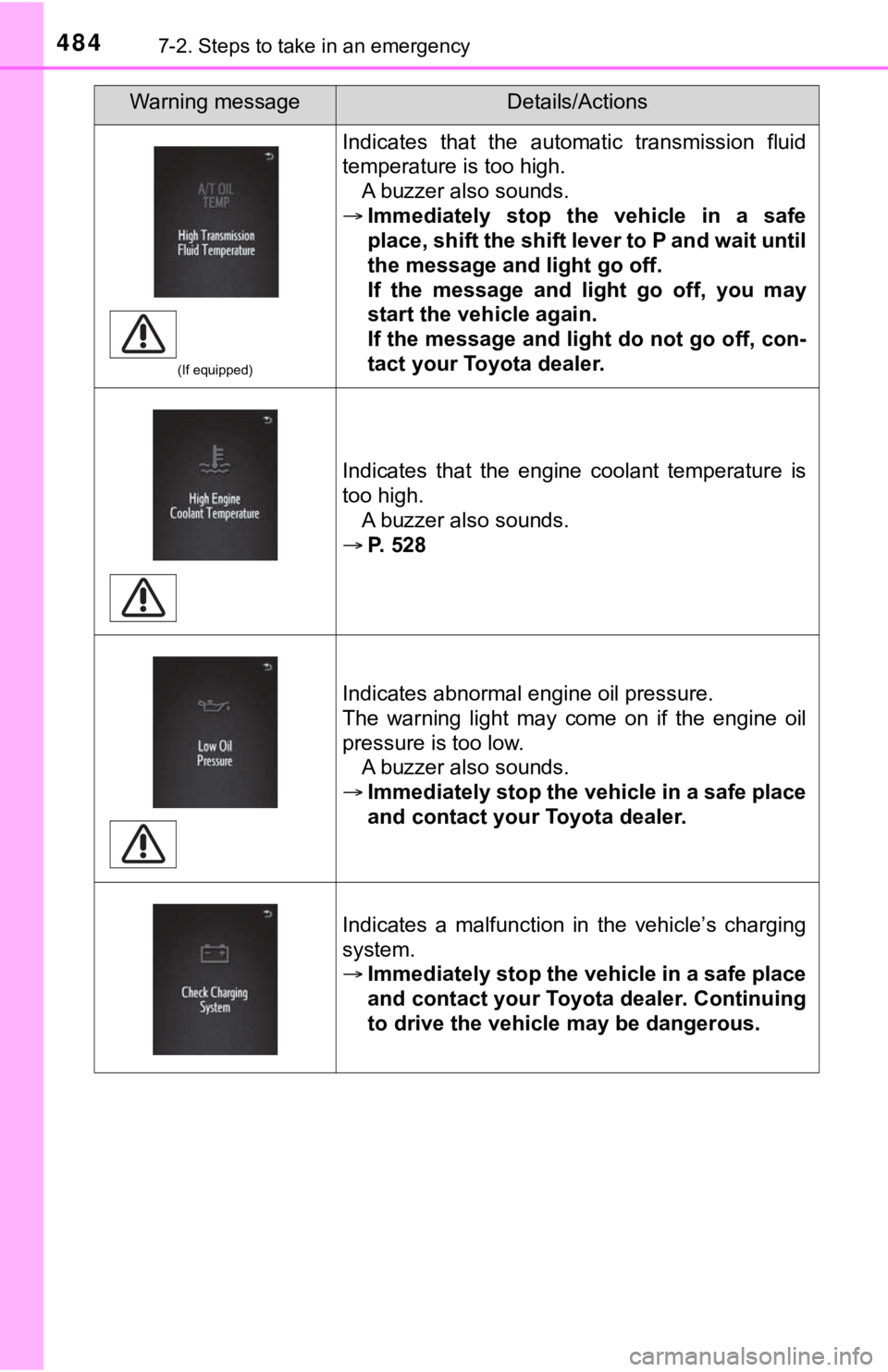
4847-2. Steps to take in an emergency
(If equipped)
Indicates that the automatic transmission fluid
temperature is too high.A buzzer also sounds.
Immediately stop the vehicle in a safe
place, shift the shift lever to P and wait until
the message and light go off.
If the message and light go off, you may
start the vehicle again.
If the message and light do not go off, con-
tact your Toyota dealer.
Indicates that the engine coolant temperature is
too high. A buzzer also sounds.
P. 528
Indicates abnormal engine oil pressure.
The warning light may come on if the engine oil
pressure is too low. A buzzer also sounds.
Immediately stop the vehicle in a safe place
and contact your Toyota dealer.
Indicates a malfunction in the vehicle’s charging
system.
Immediately stop the vehicle in a safe place
and contact your Toyota dealer. Continuing
to drive the vehicle may be dangerous.
Warning messageDetails/Actions
Page 485 of 608
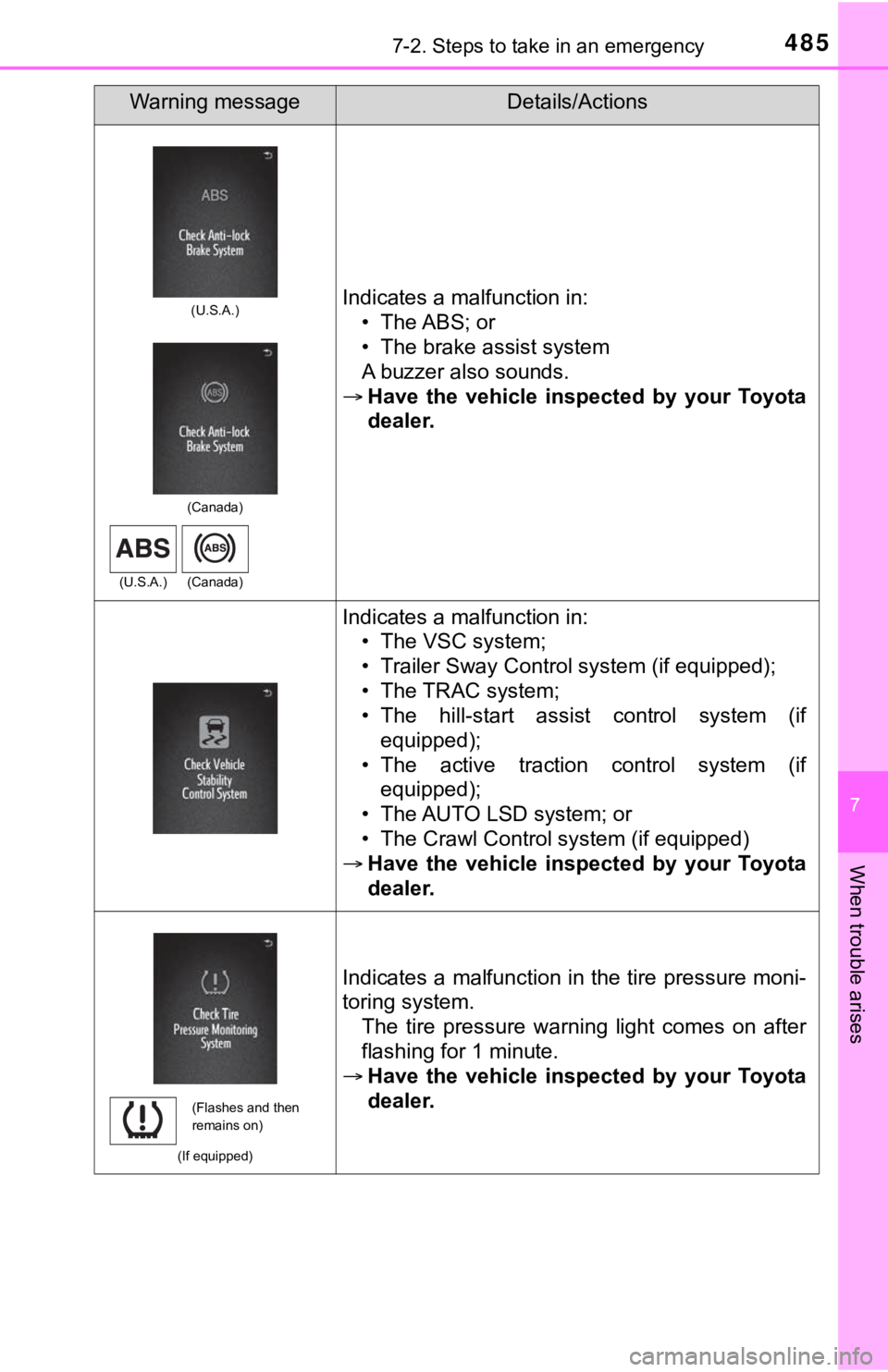
4857-2. Steps to take in an emergency
7
When trouble arises
Indicates a malfunction in:• The ABS; or
• The brake assist system
A buzzer also sounds.
Have the vehicle inspected by your Toyota
dealer.
Indicates a malfunction in: • The VSC system;
• Trailer Sway Control system (if equipped);
• The TRAC system;
• The hill-start assist control system (ifequipped);
• The active traction control system (if equipped);
• The AUTO LSD system; or
• The Crawl Control system (if equipped)
Have the vehicle inspected by your Toyota
dealer.
(If equipped)
Indicates a malfunction in the tire pressure moni-
toring system.
The tire pressure warning light comes on after
flashing for 1 minute.
Have the vehicle inspected by your Toyota
dealer.
Warning messageDetails/Actions
(U.S.A.)
(Canada)
(U.S.A.) (Canada)
(Flashes and then
remains on)
Page 486 of 608
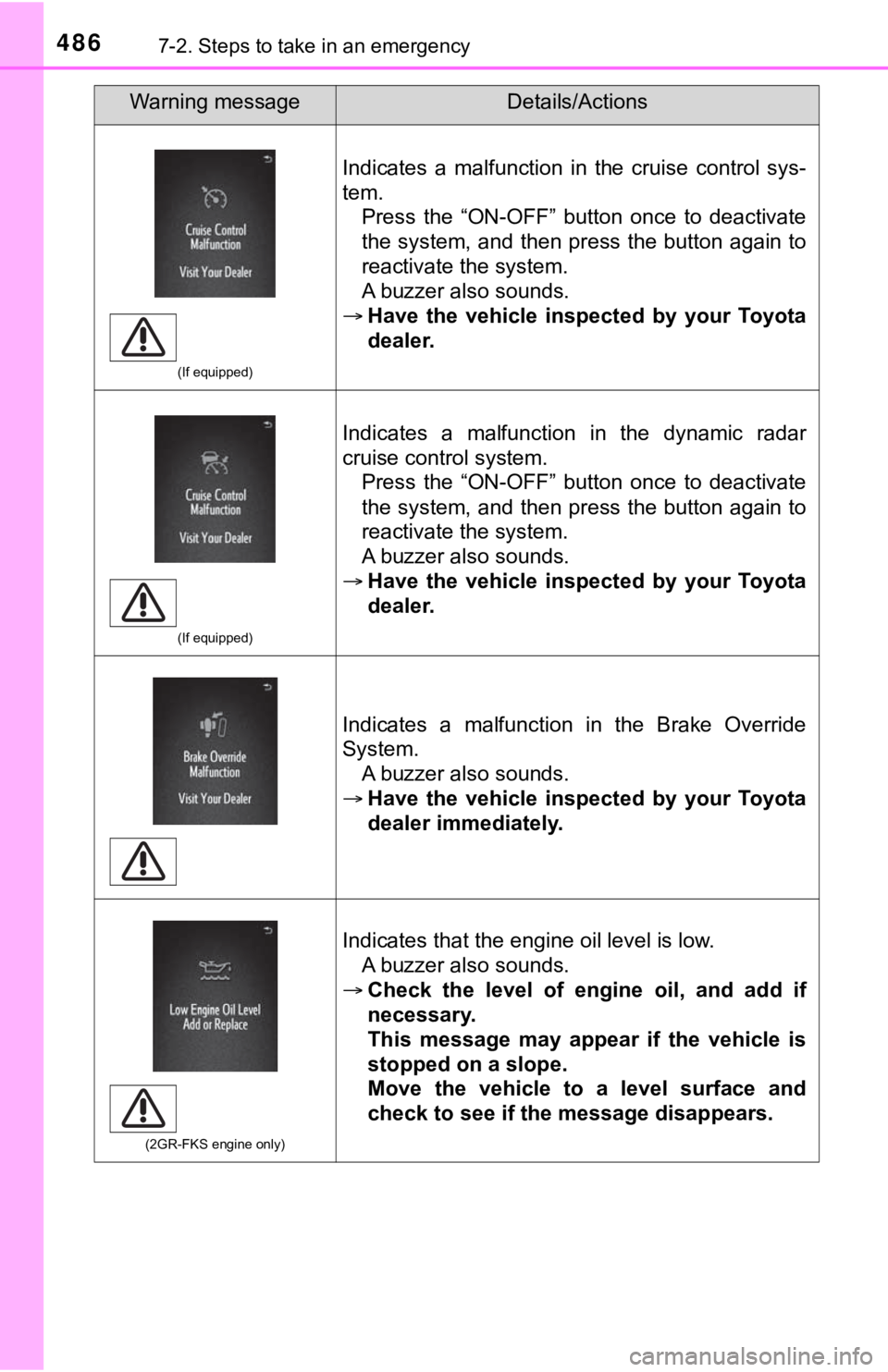
4867-2. Steps to take in an emergency
(If equipped)
Indicates a malfunction in the cruise control sys-
tem.Press the “ON-OFF” button once to deactivate
the system, and then press the button again to
reactivate the system.
A buzzer also sounds.
Have the vehicle inspected by your Toyota
dealer.
(If equipped)
Indicates a malfunction in the dynamic radar
cruise control system.
Press the “ON-OFF” button once to deactivate
the system, and then press the button again to
reactivate the system.
A buzzer also sounds.
Have the vehicle inspected by your Toyota
dealer.
Indicates a malfunction in the Brake Override
System. A buzzer also sounds.
Have the vehicle inspected by your Toyota
dealer immediately.
(2GR-FKS engine only)
Indicates that the engine oil level is low.
A buzzer also sounds.
Check the level of engine oil, and add if
necessary.
This message may appear if the vehicle is
stopped on a slope.
Move the vehicle to a level surface and
check to see if the message disappears.
Warning messageDetails/Actions
Page 487 of 608
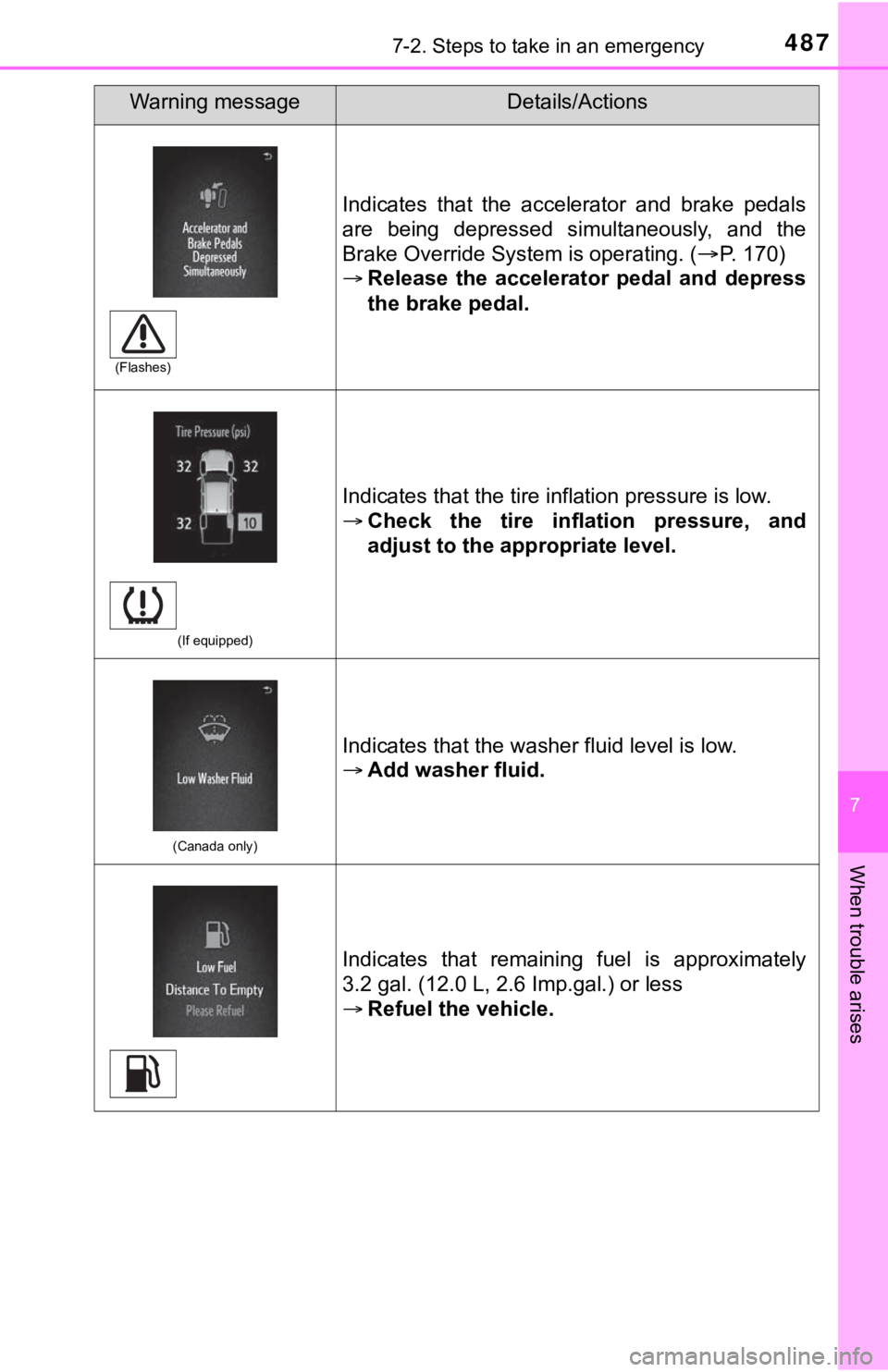
4877-2. Steps to take in an emergency
7
When trouble arises
Indicates that the accelerator and brake pedals
are being depressed simultaneously, and the
Brake Override System is operating. (
P. 170)
Release the accelerator pedal and depress
the brake pedal.
(If equipped)
Indicates that the tire inflation pressure is low.
Check the tire inflation pressure, and
adjust to the appropriate level.
(Canada only)
Indicates that the washer fluid level is low.
Add washer fluid.
Indicates that remaining fuel is approximately
3.2 gal. (12.0 L, 2.6 Imp.gal.) or less
Refuel the vehicle.
Warning messageDetails/Actions
(Flashes)
Page 488 of 608
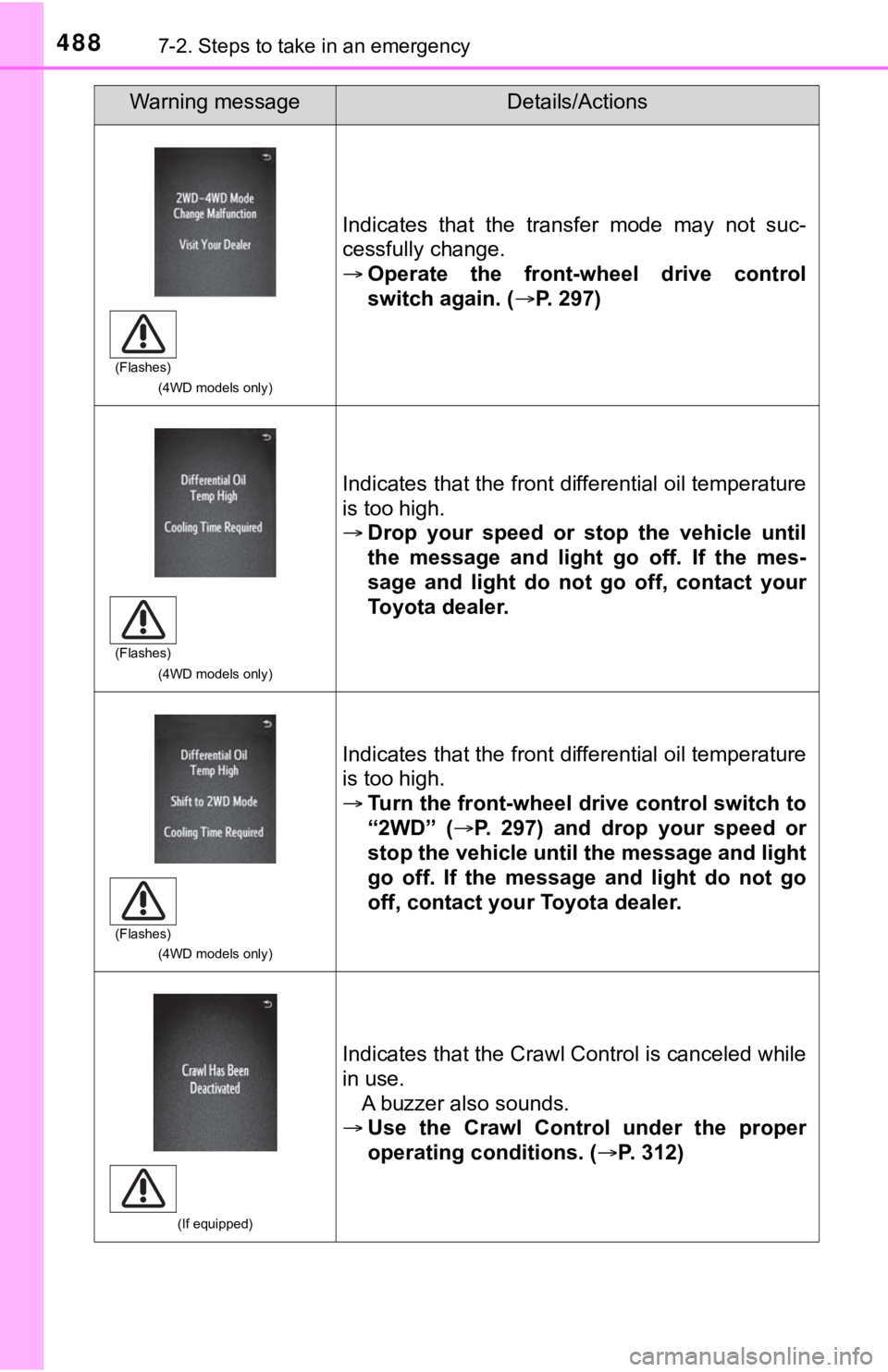
4887-2. Steps to take in an emergency
(4WD models only)
Indicates that the transfer mode may not suc-
cessfully change.
Operate the front-wheel drive control
switch again. ( P. 297)
(4WD models only)
Indicates that the front differential oil temperature
is too high.
Drop your speed or stop the vehicle until
the message and light go off. If the mes-
sage and light do not go off, contact your
Toyota dealer.
(4WD models only)
Indicates that the front differential oil temperature
is too high.
Turn the front-wheel drive control switch to
“2WD” ( P. 297) and drop your speed or
stop the vehicle until the message and light
go off. If the message and light do not go
off, contact your Toyota dealer.
(If equipped)
Indicates that the Crawl Control is canceled while
in use. A buzzer also sounds.
Use the Crawl Control under the proper
operating conditions. (P. 312)
Warning messageDetails/Actions
(Flashes)
(Flashes)
(Flashes)
Page 489 of 608
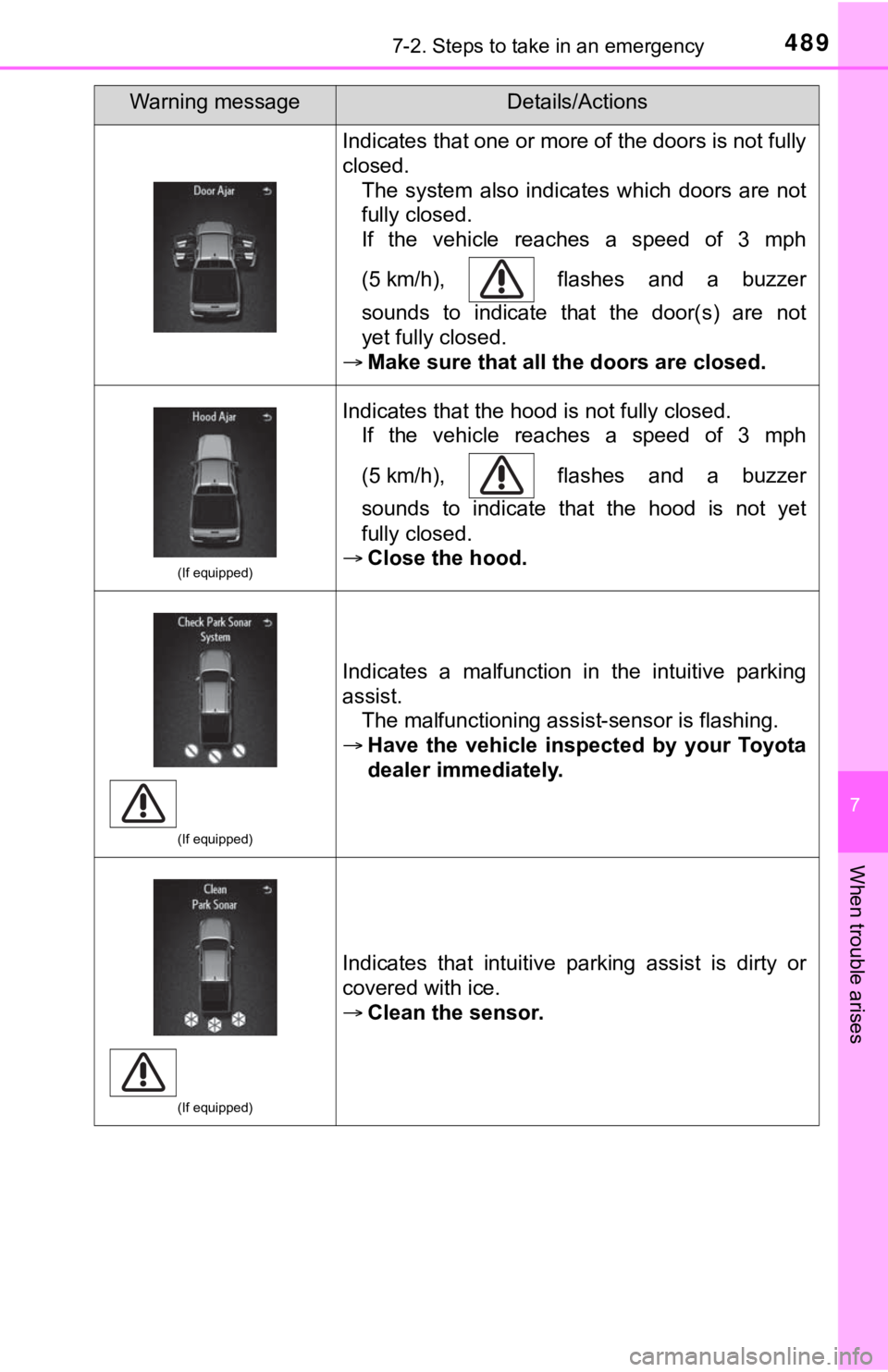
4897-2. Steps to take in an emergency
7
When trouble arises
Indicates that one or more of the doors is not fully
closed.The system also indicates which doors are not
fully closed.
If the vehicle reaches a speed of 3 mph
(5 km/h), flashes and a buzzer
sounds to indicate that the door(s) are not
yet fully closed.
Make sure that all the doors are closed.
(If equipped)
Indicates that the hood is not fully closed.
If the vehicle reaches a speed of 3 mph
(5 km/h), flashes and a buzzer
sounds to indicate that the hood is not yet
fully closed.
Close the hood.
(If equipped)
Indicates a malfunction in the intuitive parking
assist.
The malfunctioning assist-sensor is flashing.
Have the vehicle inspected by your Toyota
dealer immediately.
(If equipped)
Indicates that intuitive parking assist is dirty or
covered with ice.
Clean the sensor.
Warning messageDetails/Actions
Page 490 of 608
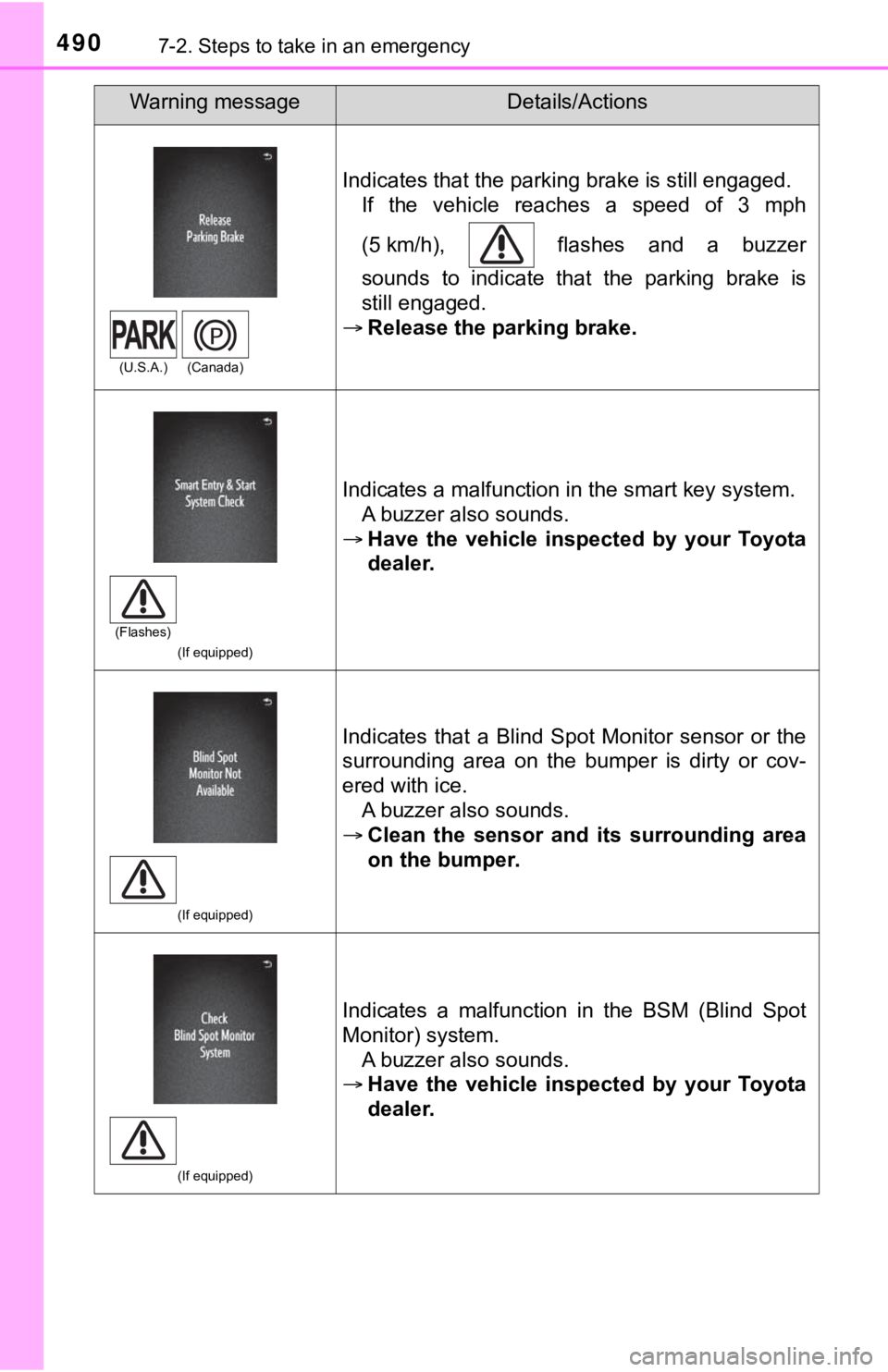
4907-2. Steps to take in an emergency
Indicates that the parking brake is still engaged.If the vehicle reaches a speed of 3 mph
(5 km/h), flashes and a buzzer
sounds to indicate that the parking brake is
still engaged.
Release the parking brake.
(If equipped)
Indicates a malfunction in the smart key system.
A buzzer also sounds.
Have the vehicle inspected by your Toyota
dealer.
(If equipped)
Indicates that a Blind Spot Monitor sensor or the
surrounding area on the bumper is dirty or cov-
ered with ice.
A buzzer also sounds.
Clean the sensor and its surrounding area
on the bumper.
(If equipped)
Indicates a malfunction in the BSM (Blind Spot
Monitor) system. A buzzer also sounds.
Have the vehicle inspected by your Toyota
dealer.
Warning messageDetails/Actions
(U.S.A.) (Canada)
(Flashes)